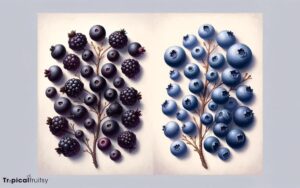What Color Are Acai Berries? Unveiling Nature’s Hue!
Acai berries are typically dark purple to almost black in color when they are ripe.
The dark purple to almost black color of acai berries indicates their ripeness and is due to their high antioxidant content, particularly anthocyanins.
This deep hue not only makes acai berries visually appealing but also suggests their potential health benefits.
Acai berries are often used in dishes and beverages, contributing both flavor and color to creations like smoothie bowls and juices.
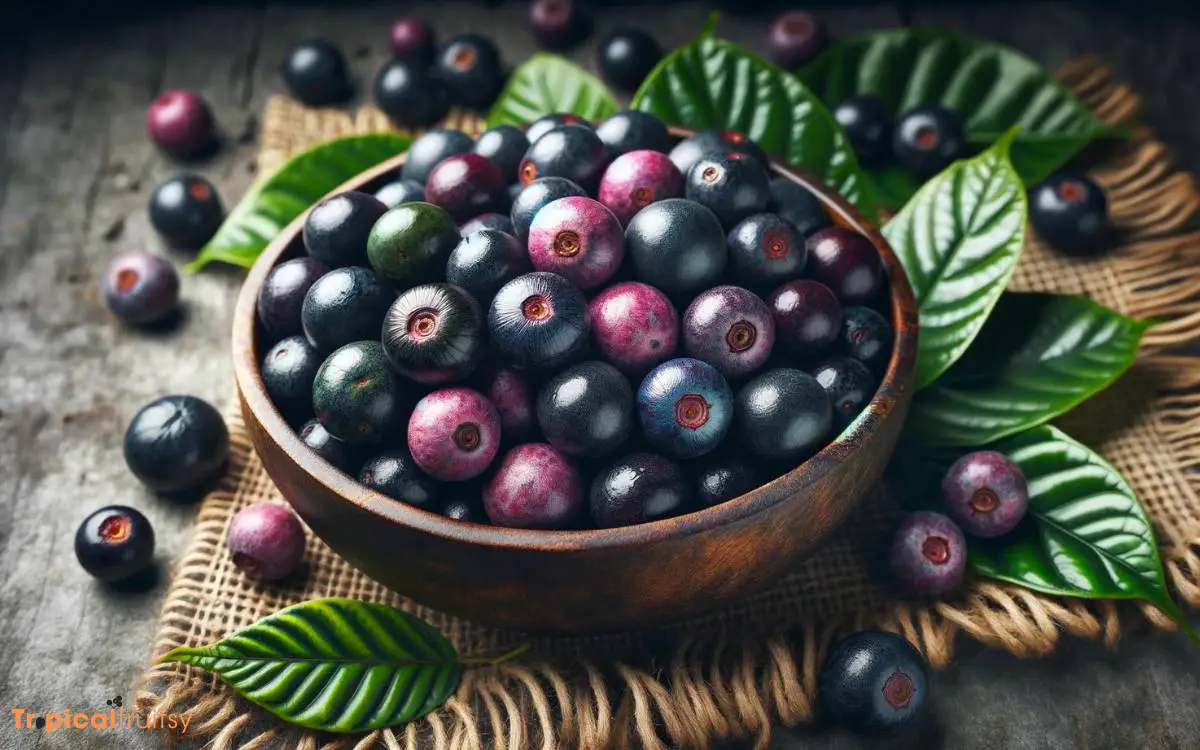
Key Takeaway
The Acai Berry Defined
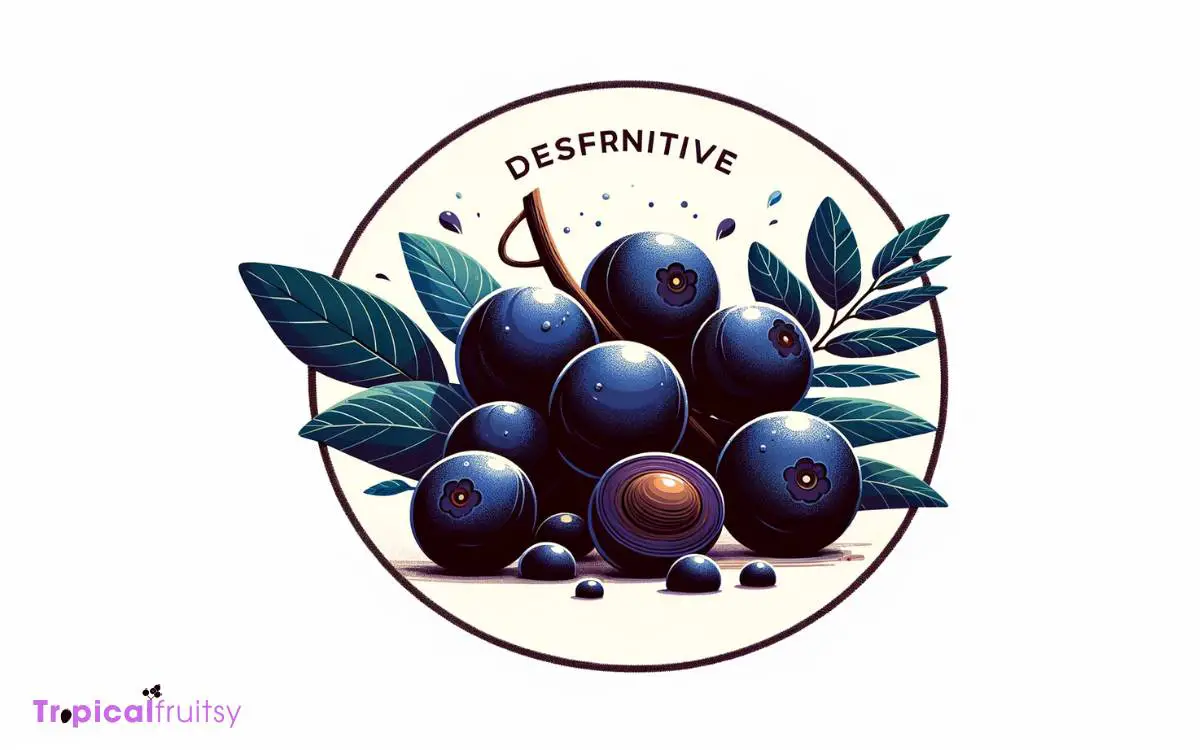
The acai berry, commonly harvested from the acai palm in the rainforests of South America, is a deep purple drupe with a rich nutritional profile.
Esteemed for its high concentration of antioxidants, particularly anthocyanins, which impart the characteristic hue, the berry is also replete with essential fatty acids, fiber, and a variety of minerals.
Scientific scrutiny reveals that its purported health benefits, including anti-inflammatory properties and potential to bolster cardiovascular health, are underpinned by its dense composition of bioactive compounds.
The acai berry’s profile includes plant sterols that may contribute to cholesterol management.
The precise, dark pigmentation of the berry not only distinguishes its appearance but also serves as an indicator of its potent phytochemical content.
Unveiling the Acai Color
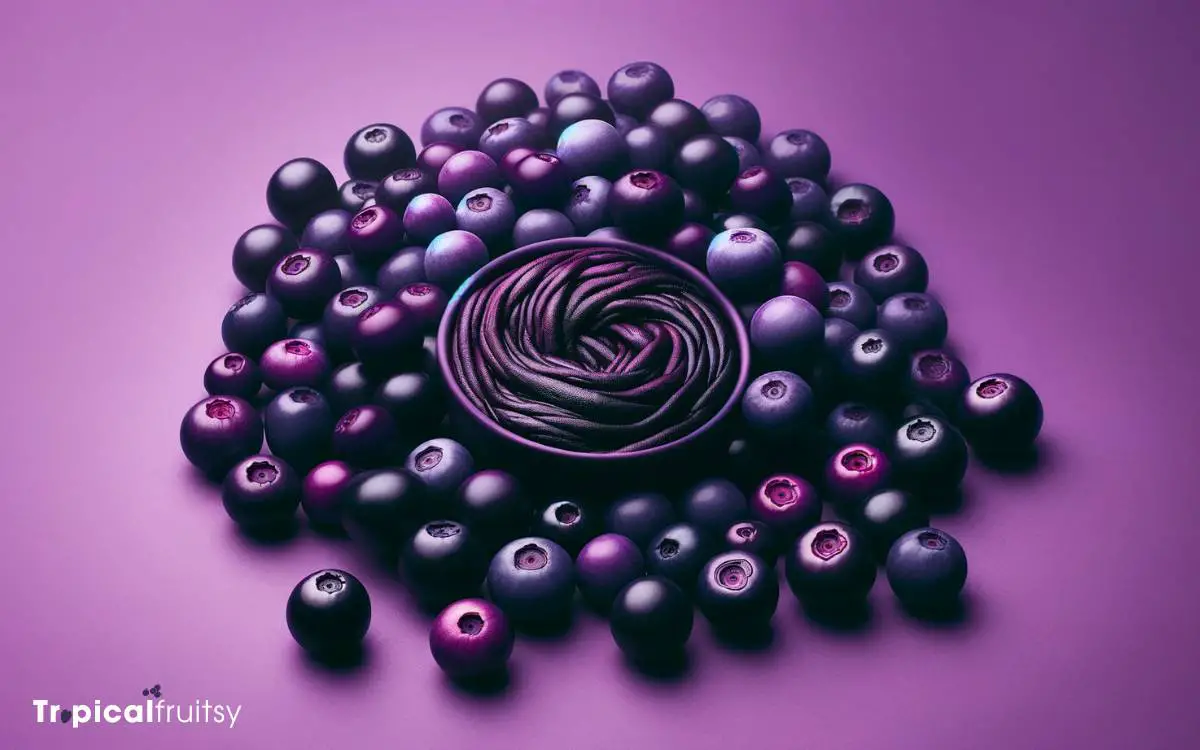
The chromatic profile of acai berries is predominantly characterized by a deep, rich purple hue. This purple color is indicative of their high anthocyanin content.
Variations in color intensity and tone can be attributed to environmental factors, genetic diversity, and maturation stages.
A rigorous examination of these variables promises to elucidate the underlying mechanisms influencing the acai berry’s distinctive pigmentation.
Acai’s Deep Hue
Nearly every acai berry boasts a rich, deep purple color that is almost black, indicative of its high antioxidant content.
This distinctive pigmentation is due to anthocyanins, potent phytochemicals renowned for their role in oxidative stress mitigation.
Scientific scrutiny has demonstrated that the depth of the berry’s color correlates with its anthocyanin concentration, suggesting that darker berries may offer more robust health benefits.
| Attribute | Implication |
|---|---|
| Deep Purple Hue | High Anthocyanin Content |
| Near Black Color | Maximum Antioxidant Capacity |
| Color Variation | Indicator of Nutrient Density |
Analyzing the acai berry’s coloration is more than an aesthetic endeavor; it provides insights into its phytochemical profile and nutritional value, reinforcing the significance of its hue as a marker of potential health benefits.
Color Variation Factors
Acai berries’ color can vary due to factors such as the berry’s maturity, environmental conditions, and genetic variations.
As a nutrient-dense fruit, the acai berry’s pigmentation is a key indicator of its phytochemical content and potential health benefits.
The hues range from a deep purple to a less saturated greenish-purple, depending on several determinants:
- Maturity Stage: Immature acai berries exhibit a green color that deepens with ripening.
- Environmental Stress: Sunlight exposure and soil composition can alter pigmentation.
- Genetic Diversity: Different cultivars may present variations in color saturation.
- Harvesting Time: The period during which berries are harvested can affect their color.
- Processing Methods: Post-harvest treatment can influence the final color of acai products.
Color Variation in Acai Berries
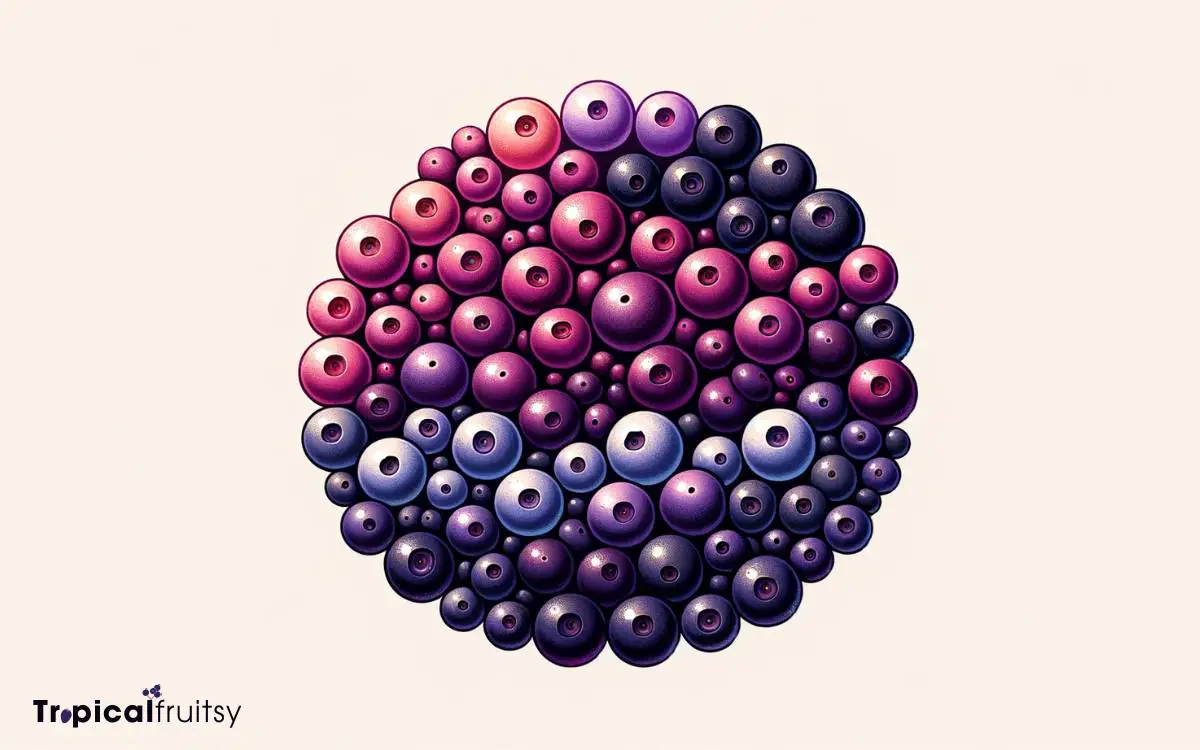
Acai berries exhibit a spectrum of coloration, indicative of the natural variation within the species, Euterpe oleracea.
The hue of these drupes shifts considerably with the progression of ripeness, transitioning from green to deep purple as they mature.
Furthermore, environmental factors such as sunlight exposure can influence the pigmentation intensity, potentially affecting the antioxidant properties associated with the berries’ color.
Acai Natural Color Range
The natural color range of acai berries varies from a deep purple to an almost black hue, reflecting their rich anthocyanin content.
This pigment variation is indicative of the berries’ maturity and the specific environmental conditions in which they are cultivated.
Notably:
- Deep purple: Signifies a high concentration of anthocyanins, commonly associated with younger, ripe berries.
- Dark purple: Often observed in berries that are fully mature and at peak harvest time.
- Purplish-red: May occur in berries exposed to certain pH levels during growth.
- Almost black: Indicates the highest anthocyanin concentration, typically found in the most mature berries.
- Slight greenish hue: Rarely, unripe acai berries can exhibit a greenish tint before maturation.
These chromatic variations are essential for gauging the ripeness and nutritional value of acai berries, providing critical information for both cultivators and consumers.
Ripeness Impacts Hue
Berry coloration in acai fruit serves as a reliable indicator of ripeness, with hues progressing from green to deep purple as the berries mature.
This chromatic transition is not merely aesthetic; it reflects complex biochemical processes within the fruit.
During ripening, anthocyanins plant pigments belonging to the flavonoid group accumulate in the acai berry’s exocarp.
These compounds are responsible for the fruit’s characteristic purple color and have been studied for their antioxidant properties.
The intensity of the purple hue increases with the concentration of these pigments, which correlates with the maturity of the berry.
Consequently, a richer, darker purple signifies a riper fruit with potentially higher nutritional value. This gradation in color, therefore, is integral for both harvest timing and determining nutritional content.
Sunlight Effect on Color
Exposure to sunlight can significantly influence the coloration of acai berries, leading to variations in hue from one fruit to another.
The intensity and duration of sunlight on the acai palm can cause differential pigmentation within the clusters of berries. This variable light exposure results in a spectrum of colors, even among fruits from the same plant.
- Anthocyanin Concentration: Sunlight increases anthocyanin levels, deepening the berry’s color.
- Shade-Grown Berries: Less sunlight may produce a lighter, more reddish hue.
- Direct Sunlight: Can lead to a darker, almost black appearance.
- Partial Sun Exposure: Creates a gradient of coloration on individual berries.
- UV Radiation: Influences the rate of pigment development and degradation.
These factors contribute to the complex presentation of acai berries’ color, which is a dynamic trait rather than a static one.
Significance of Acai Pigmentation
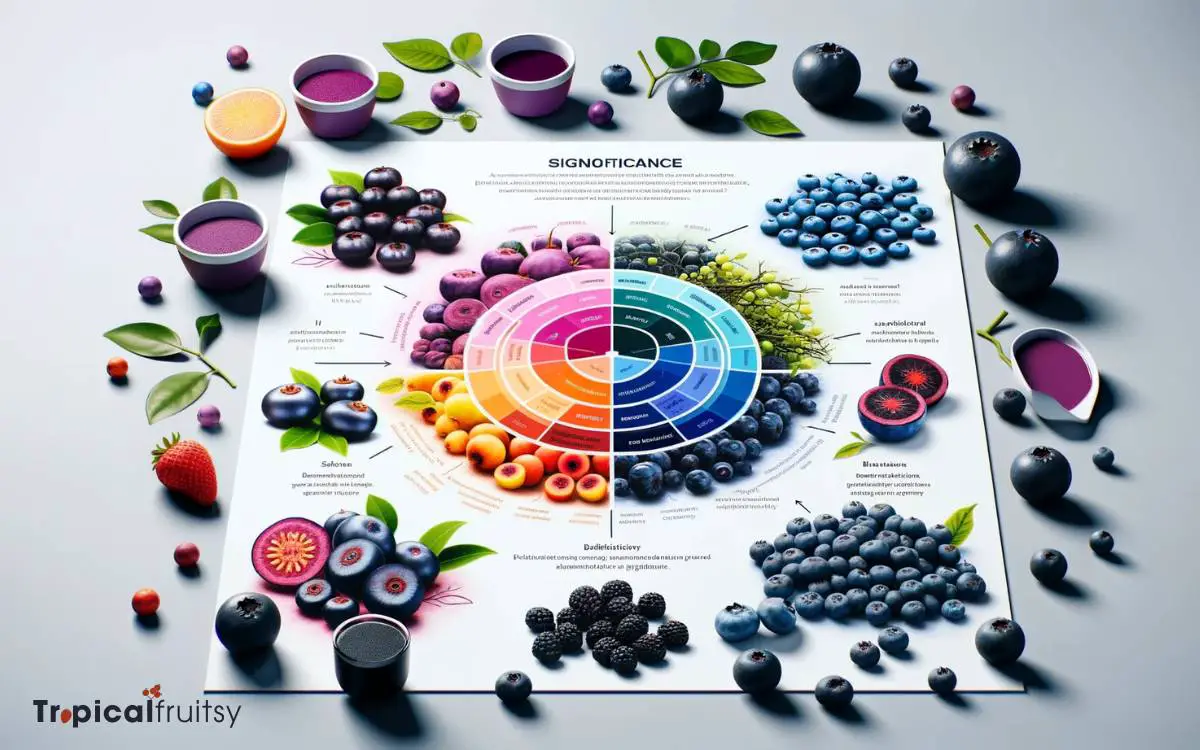
While the deep purple hue of acai berries is visually striking, it also serves as an indicator of the fruit’s rich antioxidant content, which is integral to its health-promoting properties.
The pigmentation is predominantly due to anthocyanins, a class of flavonoids with potent antioxidant effects.
These compounds are of considerable interest to the scientific community for their potential to mitigate oxidative stress and related chronic diseases.
| Compound | Significance |
|---|---|
| Anthocyanins | Contribute to the berry’s color and antioxidant capacity. |
| Flavonoids | Offer protection against cellular damage and inflammation. |
| Antioxidants | Combat oxidative stress and may reduce disease risk. |
| Polyphenols | Linked to improved brain function and heart health. |
This chromatic characteristic thus not only defines the acai’s aesthetic appeal but also encapsulates its nutritional and medicinal value, underscoring the importance of phytochemicals inherent in the berry’s pigmentation.
Acai Color and Antioxidant Connection

Throughout the maturation process, the color of acai berries transitions from green to a deep purple, signaling a concomitant increase in antioxidant levels.
This chromatic shift is indicative of the accumulation of anthocyanins, potent antioxidant compounds that confer health benefits and are responsible for the berries’ coloration.
The relationship between the deepening shade of acai berries and their antioxidant capacity is both direct and quantifiable.
The following points elucidate this connection:
- Anthocyanins exhibit strong free radical scavenging abilities.
- The intensity of the purple hue correlates with anthocyanin concentration.
- Antioxidants in acai protect against oxidative stress.
- Darker berries generally possess higher antioxidant potency.
- Spectrophotometric methods can measure the antioxidant capacity relative to color intensity.
This analytical observation underscores the significance of color as an indicator of nutritional value in acai berries.
Impact of Harvesting on Color

Harvesting acai berries at optimal ripeness is crucial for preserving their characteristic deep purple hue and ensuring maximum antioxidant content.
The timing of harvest is not merely a matter of visual aesthetics but a determinant of nutritional value.
When acai berries are harvested too early, they exhibit a greenish color, indicative of underdevelopment and a lower concentration of anthocyanins, the pigments responsible for the berries’ coloration and antioxidant properties.
| Harvesting Stage | Berry Color |
|---|---|
| Optimal Ripeness | Deep Purple |
| Slightly Unripe | Purple-Reddish |
| Overripe | Dark Purple |
| Premature | Greenish |
| Post-Harvest Aging | Brownish-Purple |
Color changes in acai berries post-harvest can also serve as a proxy for the degradation of their phytochemicals, underscoring the importance of precise harvest timing and post-harvest handling.
Processing Effects on Acai Shade

The processing of acai berries, including methods such as freeze-drying and pasteurization, can significantly alter their natural coloration.
These processes can lead to variations in hue, ranging from deep purple to a less vibrant brownish-purple.
The mechanisms behind these color changes are multifaceted and can be attributed to several factors:
- Freeze-drying: Sublimation of ice crystals can concentrate pigments, potentially deepening the color.
- Heat pasteurization: High temperatures may degrade anthocyanins, leading to a duller appearance.
- pH adjustments: Processing additives can shift the pH, influencing pigment stability and shade.
- Oxidative reactions: Exposure to oxygen during processing can cause enzymatic browning.
- Storage conditions: Light and temperature during storage post-processing can further affect color stability.
Understanding these factors is critical for preserving the acai berry’s appealing visual and nutritional qualities.
What Color Are Acai Berries and How Are They Related to the Amazon Rainforest?
Acai berries, native to the Amazon rainforest, are deep purple in color and known for their rich antioxidant content. These small, round fruits thrive in the tropical climate of the Amazon and have been a staple in the diets of indigenous people for centuries. The acai berries origin in amazon has deep cultural and ecological significance.
What Color Acai Berries Are And Do They Have A Smell?
Acai berries are deep purplish, almost black in color. They have a subtle, earthy aroma that some describe as a combination of red wine and chocolate. The acai berry scent explanation lies in the organic compounds found in the fruit, which contribute to its unique smell.
Preserving the Vibrant Acai Hue

Several strategies are employed to maintain the rich, purple hue of acai berries during processing and storage. Antioxidant-rich compounds within the berries, primarily anthocyanins, are responsible for this distinctive coloration.
To mitigate degradation, processors often utilize cold storage, reducing exposure to heat which can precipitate the breakdown of these pigments.
Additionally, modified atmosphere packaging is employed to lower oxygen levels, curtailing oxidative reactions that can lead to discoloration.
When creating acai products, such as powders or pulps, lyophilization or freeze-drying techniques are favored over heat-drying methods, to preserve color integrity.
These techniques, grounded in an understanding of the chemical stability of anthocyanins, are critical for retaining the visual appeal and nutritional quality of acai berry products.
Conclusion
The distinctive chromaticity of acai berries is not merely an aesthetic trait but a critical indicator of their phytochemical content and, by extension, their nutritional value.
As research progresses, the implications of color on the berry’s antioxidant properties and the influence of cultivation and processing methods on its pigmentation are continually revealed, underscoring the complexity inherent in these diminutive yet potent drupelets.
This vibrant hue, therefore, is emblematic of the acai berry’s profound biological significance.



